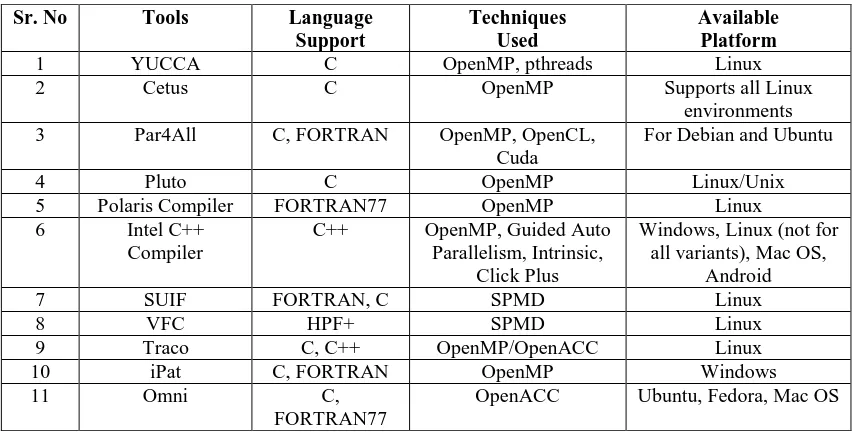166
Serial to Parallel Code Converter Tools: A Review
Dr. Amit Barve
1, Saanchi Khandelwal
2, Nujhat Khan
3, Shamali Keshatiwar
4, Swapnali Botre
5Computer Engineering1, 2, 3, 4,5,VIIT,PUNE 1, 2, 3, 4,5
Email: barve.amit@gmail.com1, saanchik94@gmail.com 2 , khan.nujhat@gmail.com3, shamalikeshattiwar@gmail.com4, swapnalibotre42@gmail.com5
Abstract- The arrival of multi-core architecture has extremely encouraged the area of parallel computing. This multi-core model has enforced a change in the way applications are written. Multi-core processors have taken the plunge to increase the performance of an application by utilizing the benefits of parallelization. However, including parallelism in a program is not an easy task. This requires parallel programming expertise. In addition to this manual parallelization of legacy serial codes is a strenuous and time consuming job. A number of tools have been developed to automate the process of parallel compilation. These tools use the parallel programming libraries to convert serial program into parallel one. This paper addresses various issues in the implementation of serial to parallel code conversion with existing techniques used to resolves issues. The paper also presents a survey of available tools used in serial to parallel code conversion, tools are compared on the basis of their features, and a few tools are compared on the basis of their performance.
.
Index Terms- Parallel Converter Tools, Multi-Core Machines, Parallelization Techniques.
I. INTRODUCTION
Parallel architectures have been advancing over the past few decades. According to Hall et al [1], in the present decade i.e. 2010 to 2020 compiler research will play a critical role in addressing two of the major challenges facing the overall computer field:
• Security and reliability of complex software systems.
• Cost of programming multi-core processors. The clock rate of the machine has almost reached its theoretical limit, in spite of that the machine speed is still continuing to increase impressively due to increased parallelism in the form of multi-core execution units. This trend of parallel architecture is one of the greatest challenges for the processor and software industries. Initially, only scientific researchers were in need of parallel programming. But now-a-days even general programmers are also interested in parallel programming. The invention of multi-core increased the speed of the processor. But this development of multi-core processors accompanied with it a disadvantage as most of the legacy applications or software’s are written in sequential manner and therefore are unable to utilize the complete power of multi-core. This limitation urges the use of parallel programming. Also providing training in parallel programming is a difficult task if time and cost are to be considered. Therefore, there is a need of assistance tools for parallel programming. These tools take the serial code as
input and generate output code with parallelization constructs. These tools help in increasing the performance and efficiency of a system.
II. ISSUES IN IMPLEMENTATION OF SERIAL TO PARALLEL CODE CONVERTER
The following issues need to be address before designing a serial to parallel code converter.
1. Dependency Analysis: Dependency
analysis needs to be carried out to parallelize the application. Dependency analysis represents how different parts of the program are interdependent and how changes in one part may affect the other. Dependencies can be categories in two types: control dependency and data dependency. Control dependency is a situation where the execution of a part or statement in the program depends on the output of execution of another part or statement in the program. Whereas data dependency is a situation where an instruction is dependent on a previous instruction it can further be categorized into four types.
171
information. CAPO generates the compiler directives in following three stages:
1) Identifying parallel loops
2) Constructing parallel regions around parallel loops and optimization of these parallel regions
3) Automatically identifying private, reduction, induction and shared variables to insert directives
Although CAPO generates directives automatically, user interaction is still important for producing parallel codes. A graphical user interface is therefore included in the CAPO tool so that a user can interact with the parallelization process [23].
V. COMPARISON OF SERIAL TO PARALLEL CONVERTER TOOLSThe tools presented in section III are compared on the basis of language support for parallelism, various techniques used in tools, support to platform and other various features. Table 1 gives comparison of various tools on the basis of language support for parallelism, various techniques used in tools, support to platform. And table 2 provides a comparison of the tools on the basis of their properties. The meanings of the columns in the table are as follows:
• F.I = Function Inlining • A.P = Array Privatization
• R.V.R = Reduction Variable Recognition • I.V.S = Induction Variable Substitution • G.T = GCD Tests
172
Table 1: Comparison of tools based on language, techniques and platform
Sr. No Tools Language
Support
Techniques Used
Available Platform
1 YUCCA C OpenMP, pthreads Linux
2 Cetus C OpenMP Supports all Linux
environments
3 Par4All C, FORTRAN OpenMP, OpenCL,
Cuda
For Debian and Ubuntu
4 Pluto C OpenMP Linux/Unix
5 Polaris Compiler FORTRAN77 OpenMP Linux
6 Intel C++
Compiler
C++ OpenMP, Guided Auto Parallelism, Intrinsic,
Click Plus
Windows, Linux (not for all variants), Mac OS,
Android
7 SUIF FORTRAN, C SPMD Linux
8 VFC HPF+ SPMD Linux
9 Traco C, C++ OpenMP/OpenACC Linux
10 iPat C, FORTRAN OpenMP Windows
11 Omni C,
FORTRAN77
OpenACC Ubuntu, Fedora, Mac OS
Table 2: Comparison of Tools Based on Available Features
Sr. No Tools F.I A.P R.V.R I.V.S G.T S.P T.P L.P P.M V
1 YUCCA
2 Cetus
3 Par4All
4 Pluto
5 Polaris
Compiler
6 Intel C++ compiler
7 SUIF
8 VFC
9 Traco
10 iPat
174 [15]. http://www.ece.lsu.edu/jxr/pluto/
[16]. http://polaris.cs.uiuc.edu/polaris/polaris-old.html/
[17]. https://software.intel.com/en-us/intel-compilers
[18]. http://sourceforge.net/projects/ipat/
[19]. http://www.hindawi.com/journals/sp/1999/30 4639/abs/
[20]. http://suif.stanford.edu/suif/suif2/
[21]. www.hpcs.cs.tsukuba.ac.jp/omni-compiler/ [22]. http://issf.sourceforge.net/

